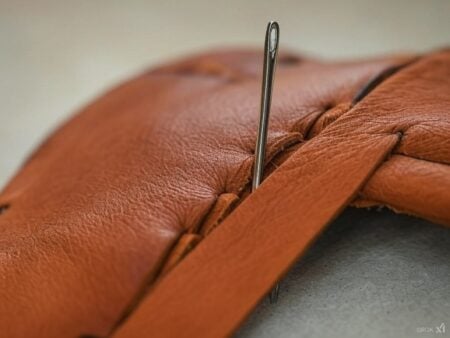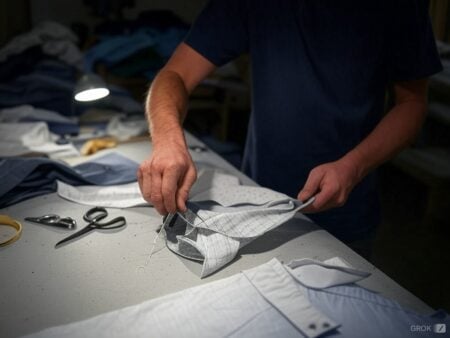One classic garment project you can undertake that is considered perfect if you are looking for versatility, comfort, and cozy, is the ever famous turtleneck.
For many sewing enthusiasts it is their go comfort project in winters. Not only is it extremely rewarding but also helps you make a personal testament with your unique preferences.
Do you want to take the turtle as your next challenge, but feel it to be a little daunting?Then you came to the right place!
In this guide, we go over everything you need to know to sew a turtleneck. From selecting the right fabric to giving it proper finishing touches, Here my five step method to do this masterfully.
Interested? Let’s begin!
1. Choosing the Right Fabric
Okay, let’s begin our journey with fabric selection.

First and foremost, let’s begin by clearing a misunderstanding, many people believe that all turtlenecks share common properties as they are all done with or from knits thanks to its comfort fit over your head and neck.
However, they don’t share the fabric types, in fact depending on the fabric type you can easily get. Here are the most popular ones. We recommend that you use some popular fabric options included.
1.1 Jersey Knit
The first choice is ofcourse the jersey knit. A common choice for turtlenecks. It is known for its soft and stretchy nature. On top of that it is preferred as it drapes well.
Now, if you plan to go with jersey knit then you wanna keep in mind that it comes in various weights.
One pro tip: if you are having trouble with deciding which ones to go with, you can follow these rules; you only work with a lighter one if you need a fitted turtleneck and you only work with a heavier one if you need to make the finished project feel more cozier than light.
1.2 Rib Knit
Moving on to the next thing you can rely on is the Rib knit. Known for its excellent stretch and recovery properties, It is great for traditional turtlenecks. What makes it valuable is that rib knit fabrics have raised vertical lines. That will help you achieve a more textured look.
1.3 Interlock Knit
The third knit you can rely on is the famous interlock knit. Might be a little daunting for the beginner, It is a double-knit fabric that is known for its thickness. The reason that matters is that it creates more stability in the finished product compared to the typical single-knit fabrics finishing..
If you want something that is more durable and stand out among the crowd of casual wears that interlock knit is what you need to utilize.

1.4 French Terry
Nextup is the french terry knit., especially in casual wear.
What if you want to tackle the casual crowd with your project? Which means you need something that has a smoother face and texture.
This is where french terry knit comes into the picture. It is a knit fabric with loops on the wrong side and a smooth face which makes it a really popular choice for turtlenecks for casual selections.
1.5 Sweater Knit
Last but not the least is the sweater knit. This one is more straightforward compared to the others. If you’re looking to create a turtleneck sweater then you need to go with sweater knit fabrics. It is time tasted knit styles that is known for its warmth and coziness properties. Also It offers textured patterns like cables or ribs.
2. Sewing the Turtleneck
Now it’s time to sew your turtleneck. Follow these steps:
2.1 Preparing you Pattern
Alright, we are almost ready to start the sewing process step but you need to do one more thing before we start, prepare your pattern!
Luckily, you can find turtleneck patterns without breaking in a sweat using the ever helpful, sewing pattern books Or you can create and draft an existing t-shirt pattern.
Regardless of where you get your pattern from, remember to consider the style, neck height, and specific seam is something you achieve on your own. The last thing you want to do with a turtleneck is to compromise it, as remember winter wind won’t be so kind to your wearer.

2.2 Prepare Your Sewing Machine
Okay from here on out let’s get into the actual process.
First and foremost set up your sewing machine with the appropriate needle and thread. Use a ballpoint or stretch needle designed for knit fabrics.
Then with the right sides of the fabric facing each other you wanna pin and sew the shoulder seams together.
Here if you are having trouble you can utilize a stretch stitch like a narrow zigzag. Though, if you are not a beginner then we recommend using straight stitch with a stretch stitch instead as it get you a little bit more reinforcement.
2.3 Add the Sleeves (if applicable)
Alright next is adding the sleeves! Simply you wanna pin them to the armholes with right sides together and begin to sew the sleeves in place. Here you can use a stretch stitch.
2.4 Sew the Side Seams
Next thing, let’s sew the side seams now. You wanna begin With the right sides of the fabric together, then properly pin them. If there is an issue with sleeves now you just need to sew the side seams.
2.5 Prepare the Turtleneck Collar
Okay, finally it is to get the bread and butter of the turtleneck done, the collar part.
First, To create the collar, you’re gonna cut a rectangle of fabric. Remember here that the width should be the same as the circumference of the neck opening.
One tip here is that the height can vary depending on your desired turtleneck height, so double check with your pattern.

2.6 Fold and Sew the Collar
Okay we’re almost there, now let’s get the collar done. First of all, you wanna begin by folding the collar in half lengthwise with the right sides together. Once done properly you’re gonna sew the short edges to create a loop.
Finally, find the quarter marks on both the collar and the neck opening. Simply pin the collar to the neck opening. Make sure it aligns the quarter marks.
Then to finish the project you just need to sew the collar to the turtleneck using a stretch stitch. This will ensure it stretches evenly.
Closing Thoughts
And done! You have successfully created your very own turtleneck for the world to see.
Now, Once again to customize it to your liking, you can now add embellishments. Maybe some embroidery, fabric paint, or whatever floats your boat.
Do you think we miss something? Let us know in the connect section below.








2 Comments
Sewing a turtleneck like a pro involves selecting the right fabric, such as jersey knit, rib knit, interlock knit, French terry, or sweater knit, depending on your desired style and comfort. Ensure your sewing machine is set up with the appropriate needle and thread for knit fabrics. Sew the shoulder seams, add sleeves if applicable, and sew the side seams. Create the turtleneck collar by cutting a fabric rectangle and folding it in half lengthwise before attaching it to the neck opening. Finish with embellishments or personal touches. This comprehensive guide ensures a rewarding and cozy turtleneck sewing experience.
I’ve been thinking of rocking the turtleneck, not just for its stylish appeal but also for the comfort it offers. The tips provided, like sewing the collar to the turtleneck using a stretch stitch for even stretching, were great. I’m thrilled with how the result turned out, and I’m eager to wear it out.